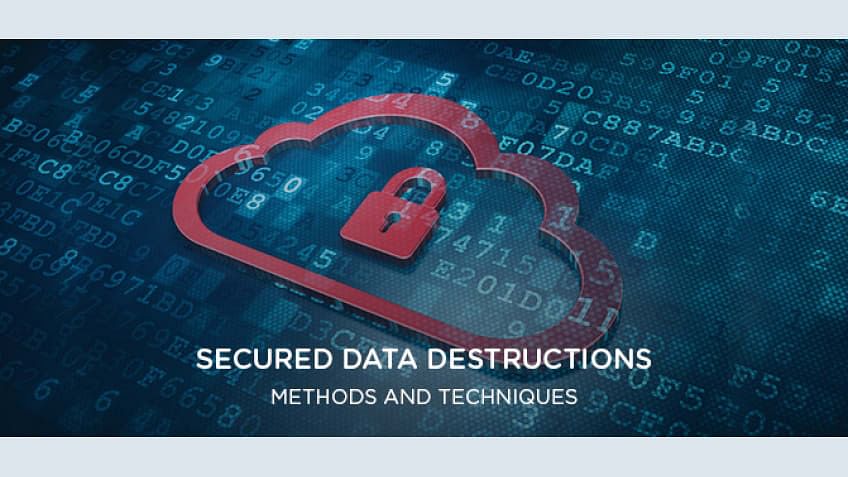Optimizing Cyber Security through Advanced Data Destruction Methods
Optimizing Cyber Security through Advanced Data Destruction Methods
Blog Article
The Necessary Nature of Data Damage in Upholding Computer Security Providers and Protecting Versus Unauthorized Accessibility
In an era where information violations and identification theft are progressively widespread, the importance of reliable information destruction can not be overstated. Different methods, from information wiping to physical devastation, offer as vital safeguards against unauthorized access.
Relevance of Data Devastation
In an increasingly electronic globe, the significance of information devastation can not be overemphasized. As companies accumulate substantial amounts of delicate info, the potential consequences of falling short to appropriately handle and get rid of of that data come to be progressively extreme. Information breaches, identity theft, and company espionage posture significant risks, underscoring the necessity of reliable data destruction techniques.

Moreover, as modern technology progresses, so too do the methods through which harmful stars look for to exploit delicate info. Organizations needs to stay attentive and aggressive in their data destruction methods to safeguard versus these progressing dangers. By focusing on information destruction, business not only secure their assets however likewise foster trust fund among clients and stakeholders, showing a dedication to liable information administration and safety and security techniques.
Methods of Effective Data Damage
To make sure the complete and irreversible destruction of sensitive information, organizations can employ a selection of reliable methods customized to their particular requirements. Among the most common approaches is data wiping, which involves making use of specialized software to overwrite existing data multiple times, making recuperation virtually impossible. This is specifically useful for difficult drives and solid-state drives, where typical deletion approaches are poor.
Another reliable method is degaussing, which utilizes strong magnetic areas to interfere with the magnetic domain names on storage space media, providing the data irretrievable. This approach is particularly fit for magnetic storage space tools, such as disk drive and difficult disks.
Physical destruction is additionally a feasible alternative, involving the shredding, squashing, or incineration of storage tools. This method assurances that data can not be recouped, making it suitable for companies dealing with very delicate information.

Compliance With Data Security Laws
Organizations have to not only concentrate on efficient information damage techniques but also ensure conformity with information defense laws that regulate how sensitive information is handled and disposed of. Abiding by these guidelines is crucial for preserving and guarding personal information consumer count on. Laws such as the General Data Security Law (GDPR) in the European Union and the Medical Insurance Mobility and Liability Act (HIPAA) in the USA enforce strict guidelines on information management, which include demands for the secure disposal of sensitive details.
To achieve compliance, organizations must execute extensive information damage plans that straighten with these legal structures. This consists of identifying information that requires damage, developing methods for secure methodsâEUR" such as shredding physical media or making use of software that fulfills industry criteria for information wipingâEUR" and preserving thorough records of damage activities. Regular audits should be conducted to ensure adherence to these plans and to recognize any type of potential areas for enhancement.
Failing to adhere to information protection laws can result in significant lawful implications, including hefty fines and damage to an organization's online reputation. As a result, integrating conformity right into information damage practices is not only a lawful responsibility yet also a critical element of a robust info safety and security method.
Effects of Poor Data Handling
Poor information handling can cause severe repercussions that expand past instant functional troubles. Organizations might deal with considerable economic losses as a result of information violations, which typically cause pricey removal initiatives, legal charges, and regulative fines. These economic ramifications can stress resources and hinder growth, eventually affecting a company's profits.
Moreover, inadequate information handling can significantly harm an organization's track record. Stakeholders, partners, and customers may lose count on an entity that stops working to shield delicate details, bring about decreased consumer commitment and possible loss of business chances. This disintegration of trust can take years to restore, if it can be recovered whatsoever.
Additionally, companies might deal with legal implications developing Go Here from non-compliance with data security laws. Such offenses may cause investigations and fines, intensifying the economic burden and more tarnishing the company's picture.
In the realm of cybersecurity, inadequate data monitoring practices can develop susceptabilities that make systems much more at risk to unapproved access and cyberattacks. Eventually, these repercussions underscore the essential significance of executing robust information taking care of treatments to guard delicate details and preserve business stability.
Ideal Practices for Secure Data Disposal
/prod01/channel_3/media/tcd/itservices/images/Untitled-design-(26).png)

First of all, data must be categorized according to its level of sensitivity. Delicate info needs extra strenuous disposal techniques, such as shredding physical papers and using advanced software program for digital information cleaning. Using certified information devastation services ensures compliance with sector regulations and requirements.
Second of all, organizations must apply a data disposal plan that mandates normal audits. This plan should outline the treatments for information retention and destruction, making sure that obsolete information is disposed of immediately and safely. Educating employees on these protocols is important to promoting a society of protection understanding.
Last but not least, maintaining detailed records of disposed data improves responsibility and offers a clear audit route. This documents should include the kind of information destroyed, the method used, and the date of disposal.
Conclusion
In verdict, the essential of reliable information devastation appears in its function in improving computer protection solutions and mitigating unauthorized access threats. Adopting robust techniques such as information wiping, degaussing, and physical damage, alongside conformity with guidelines like GDPR and HIPAA, is essential for protecting sensitive details. Ignoring proper data disposal practices can lead to serious repercussions, consisting of information breaches and lawful consequences. Applying finest methods in protected data disposal ultimately strengthens business integrity and linked here client trust.
In an era where data breaches and identification burglary are significantly prevalent, the relevance of reliable data devastation can not be overemphasized. data destruction. Information violations, identification burglary, and corporate espionage posture substantial hazards, emphasizing the necessity my explanation of effective data damage techniques
Compliance with guidelines such as GDPR and HIPAA mandates that organizations carry out rigid information protection actions, consisting of the safe damage of data at the end of its lifecycle.
By prioritizing information damage, firms not only shield their possessions however also foster trust among stakeholders and customers, showing a commitment to liable data administration and safety practices.
Organizations need to not only concentrate on reliable information damage techniques yet also ensure conformity with data security policies that control how delicate information is taken care of and disposed of.
Report this page